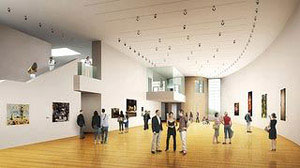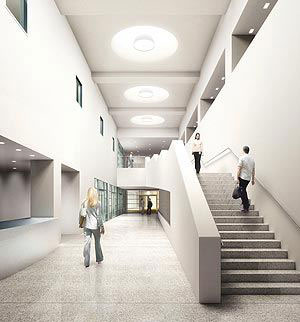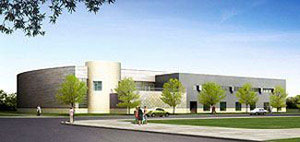
Making a Difference
An Interview with Ted Pietrzak,
Executive Director of The Burchfield-Penney Art Center
By Robert Hirsch
From Forever Young Magazine,

Ted Pietrzak,
Photo: Jim Bush.

Computer renderings of the new Burchfield-Penney Art Center provided by www.dboxstudio.com

Computer renderings of the new Burchfield-Penney Art Center provided by www.dboxstudio.com

Computer renderings of the new Burchfield-Penney Art Center provided by www.dboxstudio.com

Computer renderings of the new Burchfield-Penney Art Center provided by www.dboxstudio.com
|
Robert Hirsch: Where are you from?
Ted Pietrzak: Kitchener, Ontario Canada.
RH: What brought you to Buffalo?
TP: An opportunity to work as director of the Burchfield-Penney Art Center.
RH: What is it like being a Canadian in the US at this time?
TP: The main difference is the political climate. One has to be aware of big "P" and small "p" politics in this region in order to get things done, and it is not the same in Canada.
RH: How so?
TP: It appears many cultural decisions are made behind closed doors that do not include the individuals and organizations that are most impacted. Consider how Studio Arena's county funding was cut. It has since been restored, but why was such a decision made to basically destroy an important cultural organization? Or, what about the attempt to force a merger between the Science Museum and the Historical Society by freezing funding below adequate levels? Also, county funding for the Arts Council was completely cut because certain people thought it was less than effective, crippling an important organization. We need an open dialog that tries to fix problems by engaging in a dialogue with those people and organizations directly involved.We need an open dialogue with those people and organizations directly involved.
RH: How did you get where you are?
TP: I've worked in art museums since I was 17 - from having a part-time weekend job, to being director of three museums over the last 25 years. I got here because I was always interested in art and I thought working in art museums would allow me to sustain myself while I became a professional artist. But, I realized in the early 1980s I had to make a choice between the two.
RH: What does your work mean to you?
TP: It means I can make a difference in people's lives and in the community as a whole.
RH: What do you do during a typical week?
TP: Work dominates the week, sometimes 10- to 14-hour days, but it's exciting because we're breaking new ground. The rest of the time is spent with my wife, Marlene. I like to cook, read, listen to music and share in household chores.
RH: What are you reading?
TP: I am an eclectic reader. I just finished Bruce Feiler's Abraham: A Journey into the Heart of Three Faiths and now because of a recent trip to Hawaii, I am completing James Michener's 1959 epic Hawaii. One of the most beautifully written books I have read recently is The House of Sand and Fog by Andre Dubus III, a mesmerizing tragedy.
RH: Tell us about the plans for the new Burchfield-Penney Art Center?
TP: It's an exciting time for the institution; we've been planning for a new building for the past six years. We received input from hundreds of people in the community. We visited dozens of museums where we looked at past practices and imagined what the visitor experience should be in the 21st century. We have the design for a remarkable institution. It will be 75,000 square feet (gross) and just over twice the program space we have now. It will be a landmark building with a unique combination of exhibitions/collection and education spaces. We'll break ground in the spring of 2006 and open in late fall 2007 or early winter 2008.
RH: What are some new features?
TP: There will be expansion in gallery space of different types to meet the needs of collections and contemporary artists. There will be significant increases in educational space, as we are a resource for Buffalo State College. This will include an interactive learning space, a classroom and a collection study area, and a 156-seat auditorium. Archives will expand with a study area as scholar's office and a new art conservation lab, focusing on works on paper.A café will be added and the museum store will be expanded.
RH: What are some upcoming highlights?
TP: The exhibition project 24/12 continues, which is an exciting opportunity to view diverse and strong contemporary work by regional artists. This work represents many styles and many media; the one common thing is that the artists excel in what they do. A historical survey is planned to examine the contribution made by the Buffalo Art Institute. And the Western New York biennial exhibition is planned for this fall. People can become a member and get our mailings or visit us on the web at www.burchfield-penney.org to get updates on programs and progress with the new facility.
RH: Do you think Buffalo is a good community for artists and the arts?
TP: Yes and no. Buffalo is one of the most vibrant mid-size cities for the arts, having numerous theaters and visual arts organizations and music venues. They seem to flourish here, surprisingly, although we have a relatively small metro population of less than a million people. Nonetheless, it appears to drive great energy into the city. Artists have many opportunities no matter what their discipline. On the other hand there is very little economy for the arts here, particularly the artists who survive by working at other jobs. Commercial gallery activity is relatively small and artists deplete their own capital by the many art donations that are asked of them for countless charity auctions.
RH: How do you stretch yourself?
TP: I take on more than most people expect of themselves, but try to work wise and play wise. Work is obvious, play means many things including Marlene and I restoring our hundredyear-old house. I challenge myself with new cooking recipes and attempt to replicate what impressed me at a restaurant. I like to listen to opera and have and extensive classical music collection from the simple and melodic, such Jean Sibelius and Camille Saint-Saens, to the challenging and complex, such as Alban Berg and Arnold Schoenberg.
RH: How does Buffalo's stereotype/image impact on your job/life? What is your favorite thing about Buffalo? What would you like to see changed?
TP: Most people perceive Buffalo as a Rust-Belt City covered in many feet of snow. They think about our professional sports teams, how they many time almost made it, but didn't. What they don't think about is the vibrant culture because we haven't done a very good job telling people what exists here. I think the challenges of Buffalo besides good PR is leadership. We have a very difficult time getting on the same page and making things happen. Again it has to do with big "P" and small "p" politics, but more importantly there hasn't been an individual or a number of individuals with a clear vision for Buffalo and the ability to express it in a compelling way. The good things about Buffalo include the many opportunities to do things, both personally and professionally. For those with a positive attitude and understanding of the lay of the land, you can get amazing things accomplished here. Buffalo is also a very livable City, we have economic and social challenges in certain areas, but there is a grass roots energy that sees small retail developments change entire neighborhoods. Marlene and I love living in the Elmwood area of the City and we are five minutes away from yoga, restaurants, video stores, and the Lexington Co-Op.
RH: How does where you are now jive with how you imagined yourself when you were younger?
TP: I wanted to make a difference in a community and in people's lives and working in an art museum is one way to do that. What is different is I wanted to be an artist and found out it's extremely difficult to be an artist when one has so many administrative demands.
RH: What do you consider to be fulfilling moments on job?
TP: Creating the ceramic art collection for the Burlington Art Center, Canada where I was director, the restructuring of the visitor Center at the Art Gallery of Hamilton, Canada, and obtaining major artworks for the Burchfield-Penney Art Center's collection.
RH: Do you do any volunteer work or serve on any boards?
TP: I serve on a number of boards and do volunteer work. I am vice chair of the Buffalo Niagara Convention and Visitor Bureau and Chair of its Cultural Tourism Committee. I serve on the board of the Burchfield Nature and Art Center and I've worked for numerous committee groups, such as Roswell Park Cancer Institute, developing their arts policy. I am fairly responsive to the needs in the community where an arts organization or other non-profit requires some assistance that my expertise would allow me to share.
RH: What is your biggest challenge?
TP: It is completing our $32 million capital campaign and ensuring that the building is constructed with the appropriate equipment and detailing that will make an excellent museum.
RH: Vocation Vacations is a company that offers vacations where you alternate careers. If you went on such a jaunt what would you like to be?
TP: I would very much enjoy being a teacher, and/or a building consultant focusing on art museums, or even a development fund raising director. What truly excites me though is taking desperate elements that are itching for a place to go and making something very special happen, getting all the factors and people to line up and moving a project ahead. It could be virtually any project that would make a difference for the community.
Burchfield-PenneyArt Center, 1300 Elmwood Ave.
716-878-6011 www.burchfield-penney.org.
|